
Romanesque Route
The Ribeira Sacra is home to the greatest concentration of rural Romanesque architecture in Europe. Discover places steeped in history, art, tradition and unique nature.
We begin our route in Ourense, taking the N-540 (Ourense-Lugo) road to Chantada, where we can admire its old town and renowned arcades.
We should then take the GC-2.1 Expressway between Monforte and Lalín and, shortly after the new bridge over the river Miño, on the right-hand side we will see a sign directing us to Santo Estevo de Ribas de Miño church: a wonderful example of the Ribeira Sacra’s characteristic Romanesque style. The church, which blends perfectly into the rocky slope, looks down over the Miño valley and offers views of Belesar reservoir. Aside from admiring this monument, we can enjoy extraordinary panoramic views over the western side of the Miño, brimming with terraces.
If we then double back, we will reach the intersection with the GC-2.1 road again, where we have two options. Travelling upstream from Belesar reservoir, we can visit Santa María de Pesqueiras and San Vitorio de Ribas de Miño churches, in addition to the famous San Nicolao church in Portomarín, which was dismantled stone by stone and reconstructed when Belesar reservoir was built.
If we are short of time, we can follow the sign which directs us to San Paio de Diomondi: a 12th-century church which can be visited on Sundays at 12:00, during its religious service.
Continuing through the O Saviñao area, and moving southwards along the course of the Miño, we arrive at an intersection where we should turn right, following the signs which will lead us to San Martiño da Cova church. This Romanesque gem is set in a spot known as the “Cabo do Mundo” (Cape/End of the World): an impressive bend in the Miño south of the municipalities of Chantada and O Saviñao.
Travelling southwards, and moving into the municipality of Pantón, we reach the area with the greatest concentration of Romanesque buildings in the whole Ribeira Sacra. Our first stop is San Miguel de Eiré: a small, slender church.
After Eiré, there are three must-see Romanesque gems to visit: Santo Estevo de Atán, San Vicente de Pombeiro and San Fiz de Cangas. To reach the first of these, we will need to go to Os Peares and take a road on the left, returning again to Atán afterwards. From Atán, we briefly travel along a stretch of the N-120 (Ourense-Monforte) road, turning off shortly before Ferreira de Pantón to visit San Fiz de Cangas.
From there, we head in the direction of Monforte to reach O Castro de Ferreira (Pantón), where we can visit the Bernardine monastery, which already existed back in the 10th century and was governed by the order of San Bieito. Nowadays, the sole remnant is the church of the former female convent, which is a building with very simple architecture.
After these visits, continuing along the N-120 road, we turn off in the direction of Canaval railway station. After admiring San Pedro de Canaval church, we can then visit Santa María de Proendos and Santa María de Bolmente churches, taking a local road which starts at the municipal capital of Sober.
Don’t miss the chance to visit the Cividade viewpoint. Continuing along the same road, we will find San Vicente de Pinol and San Xillao de Lobios churches, before retracing our steps towards the N-120 and returning to Ourense.
Between the Miño Canyon and the Dorsal Galega range, with Mount Faro as its summit, the town's beautiful old quarter and numerous examples of Romanesque architecture are particularly striking.
The first sources which are known about this former monastery refer to an inventory of the bishopric of Lugo of the 12th century, being a donation by Mrs Urraca Fernández.
Between ancient forests, unwilling to disappear from history, the church of Santa María de Pesqueiras is another jewel of Romanesque architecture which is home to Ribeira Sacra.
The Church of San Juan or San Nicolás presides over the square “Praza do Camiño” in Portomarín. This village is right on Saint James´ Way and here came the order of the Knights of Saint John of Jerusalem in the 12th century to take charge of the hospital for pilgrims.
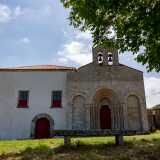
An engraving on the inside of the tympanum of the main door is dated 1170. The first documentary sources referring to this church go back to the 8th century and mention a Bishop Odoario. Ferdinand II and Alphonso IX also granted the monastery donations and privileges, which were confirmed by a number of popes, including Alexander III and Lucius III. Today, the church belongs to the bishopric of Lugo and is a parish church, after being restored as a bishopric on one occasion by King Ferdinand III in 1231. It was therefore completed at the beginning of the 13th century.
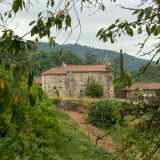
Currently only the Romanesque church is kept. It was a monastery of regular canons of St. Augustine, between the 13th century and 14th century. It was as a Priory dependent on the Cathedral of Lugo, abolished in 1824 and subsequently relegated to the current church after auctioning their goods with the confiscation of Mendizábal.
Located opposite the meander of the river Miño known as the “Cabo do Mundo”, the end of the world, it offers a spectacular panorama over the area near the banks of the river. From here you can see clearly how the vines are grown on terraces, one of the most beautiful sites in the area of Lugo.
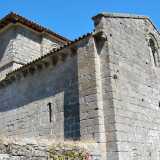
One of the most interesting examples of the Romanesque of the Ribeira Sacra and of Galicia is, without a doubt, the Church of San Miguel, commonly known as "O Mosteiro".
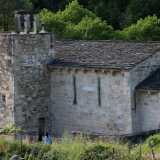
Churches of Atán, San Fiz, Pombeiro, Eiré:
you are miracles erected by faith!-And look always to the infinity.
Manuel María
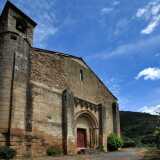
This lovely church is on the right bank of the river Sil just before it runs into the river Miño. It is surrounded by exuberant vegetation in a place chosen by the hermits of old, of whom there are some remains, such as several anthropomorphic tombs.
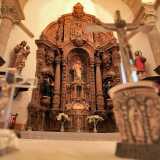
The church used to belong to a Benedictine convent. Monastic life continued at San Fiz until renovation work began at the end of the 15th century, when the nuns of this order in Galicia were obliged to move to the convent of San Paio de Antealtares in Santiago.
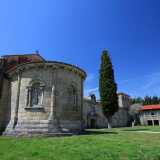
The only female monastery that keeps religious life in Ribeira Sacra. Almonst known by Monastery of Bernardas
For some historians, this was the mythical Roman Proentia, as numerous Roman remains have been found on the site and reused in different places.
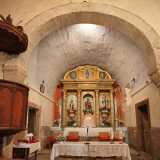
This small church is a fine example of 12th-century rural Romanesque architecture in Galicia
Accessibility
Don't miss!
Otros servicios de guías y rutas personalizadas sobre románico aquí.


 What would you improve?
What would you improve? 